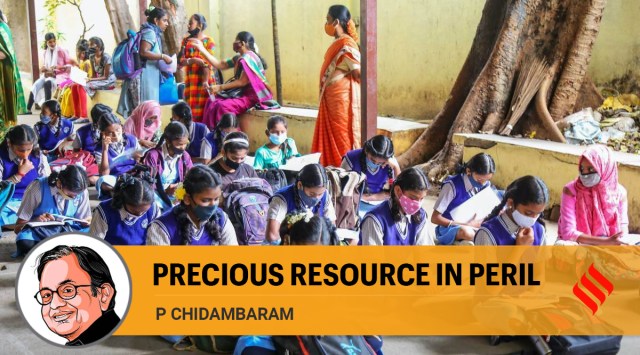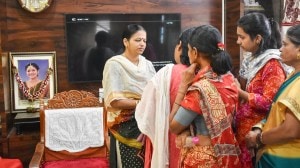- India
- International
Precious resource in peril
🔴 P Chidambaram writes: The two reports — ASER 2021 and NFHS-5 — capture the picture of real India, unlike the BSE index or the NIFTY index that capture the health of no more than 100 listed companies.
 Schools had been closed for 73 weeks against a global average of 35 weeks. Children have moved from private schools to government schools because of migration and financial distress. (PTI)
Schools had been closed for 73 weeks against a global average of 35 weeks. Children have moved from private schools to government schools because of migration and financial distress. (PTI)The Central government and its ministers speak ad nauseum on the threat from Pakistan, hostility of an unnamed neighbour (China), Hindutva, disruption of Parliament, andolan jeevis (perennial protesters), dynastic politics, 70-years-of-no-development, India is a vishwa guru (teacher to the world) and so on. However, I have not heard them speak of the status of our children, especially the status of our children’s health and education.
I have diligently followed the Annual Status of Education Report (ASER) that is published periodically. We had the reports for 2018 and 2020. Now, the ASER report for 2021 has been published on November 17, 2021.
At about the same time, the National Family Health Survey-5 (2019-21) was published. It follows the same pattern as NHFS-4, and that is helpful for making a comparison. The two reports — ASER 2021 and NFHS-5 — capture the picture of real India, unlike the BSE index or the NIFTY index that capture the health of no more than 100 listed companies. These reports have been in the public domain for the last two weeks, but I cannot recall the Prime Minister or the Education Minister or the Health Minister speaking on the two subjects.
Two Reports, Key Conclusions
The two reports assess the impact of the pandemic. They cannot be brushed aside as the results of a one-off occurrence. The conclusions of the reports are depressing. Let me list the key findings:
ASER 2021 (Rural):

1. There is a clear shift in enrollment from private to government schools.
2. There is a steady increase in children taking ‘tuition’.
3. Smartphone ownership has increased but children’s access remains an issue.
4. There is a decrease in learning support at home as schools reopen.
5. There is a slight increase in learning materials available for children.
NFHS 2019-21:
1. The Total Fertility Rate has reached 2.0 (slightly below the replacement rate), but the population of three states (also among the poorest) continues to grow at a higher rate.
2. Sex ratio among children born in the last five years has dropped inexplicably to 929 (females to males).
3. Sanitation, Clean Fuel and Health issues continue to be challenges to millions of families.
4. Mortality rates are falling, but are unacceptably high.
5. Stunting, Wasting and Anaemia are grave challenges to children.
Juxtapose the first set of conclusions on Education with the second set of conclusions on Health. It will be evident that the most precious resource of any country — children — is neglected in India, and there is scarcely any public discussion on the subject. Even the ministry exclusively set up for their welfare, the Ministry of Women and Child Development, seems to be in deep slumber.
Inequalities, Aggravated
Inequality among different sections of the people is observed in all countries. Income and wealth are the biggest differentiators. In India, those differences are aggravated by religion and caste. People from disadvantaged social and economic groups are among the poorest and the most unemployed, discriminated against and neglected by the State. You may imagine the status of their children’s education and health in comparison to other children’s.
ASER and NFHS have not done a religion- or caste-based enumeration or analysis of the data. They are about all children. Let’s consider what kind of children are growing up in contemporary India, especially when the country is affected by a pandemic. My conclusions are:
– Couples have fewer children, but they are not giving birth to an approximately equal number of male and female children. While the overall sex ratio of females to males is healthy (1,020), it has dropped alarmingly among 0-5 years to 929. This number has been contested — and it should be scrutinised rigorously — but the trend, if correct, is a matter of great worry.
– The three poorest states continue to be badly governed. They are adding to the population at a rate higher than the national average. That means more children are being added in poor states. Poverty alleviation measures seem to have failed in these states.
– Despite tall claims, India is not yet Open Defecation Free. The free-cylinder scheme (now called Ujjwala) is not the success that it is claimed to be.
 – While health infrastructure and health services have improved, maternal and child health are still neglected. We cannot accept a situation where many children are dying at birth (24.9 per thousand), during infancy (35.2) and within the first five years (41.9).
– While health infrastructure and health services have improved, maternal and child health are still neglected. We cannot accept a situation where many children are dying at birth (24.9 per thousand), during infancy (35.2) and within the first five years (41.9).
– For the children who survive, nutrition is a big challenge. This is captured in the disconcertingly high percentage of stunting (35.5 per cent), wasting (19.3) and nutritional deficiency (32.1).
– The ‘learning loss’ in 2020-21 and 2021-22 has been colossal. Schools had been closed for 73 weeks against a global average of 35 weeks. Children have moved from private schools to government schools because of migration and financial distress. The capacity of government schools to absorb the increased number of children is doubtful and many children were observed sitting in multi-grade class rooms. Only 39.8 per cent reported receiving learning material when schools had been shut. Foundational skills (reading and arithmetic) were woefully short of the level of the class.
Will the Prime Minister, the Chief Ministers and the Central and state governments spare a thought — and utter a word — about the worrisome state of our children’s health and education?
EXPRESS OPINION
More Explained
Apr 26: Latest News
- 01
- 02
- 03
- 04
- 05

 Continue with Facebook
Continue with Facebook Continue with Google
Continue with Google
































